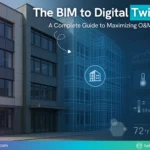5 Reasons Why Digitalization is Thriving in the AECO industry
September 21, 2022

Were the last two years the years of disruption or transformation? While almost every industry faced a slump, it forced companies to adopt long-due digitalization and acquainted many with the concept. We can say the same for the AECO industry (architecture, engineering, construction, and operations) – which is still largely personnel dependent, fragmented and new to the world of digitalization.?
We could say that several sectors, such as engineering, healthcare, manufacturing, etc., have seemingly fared better in adopting digitalization than the AECO Industry. Moreover, it is a vastly complex industry, given the interdependencies between stakeholders such as architects, engineers, contractors, suppliers, government bodies, etc. The demand for human coordination among a large pool of entities demands improved integration, faster communication, and coordination between them.?
The industry is vast and a significant player in world economics. A recent report by IBISWorld stated that there are more than?3.75 million construction businesses?in the United States alone, and the entire industry is estimated to touch USD 57 trillion by 2030.?
But how can AECO players benefit from digitalization? How can they become more efficient and make better decisions? How can the industry achieve the next level of growth? This blog might have some answers to address how it can be a game changer.?
1. Increased Efficiency?
By introducing digitalization, in turn, BIM (Building Information Modeling) to their systems, AECO companies can improve every step of the process, including planning, design, procurement, construction, etc. BIM provides the data that can be used throughout the collaborative processes in all stages of the project lifecycle. Additionally, cloud-based data-sharing applications break down data silos to make inter-disciplinary graphical and non-graphical data accessible in one place. These digital tools enable data visualization and effectively analyze how built assets are managed, delivered, operated, and maintained.?
A single digital environment allows seamless information sharing, real-time communication, and the ability to make data-driven decisions in operations and maintenance processes. All of this and more is possible with digitalization!?
2. Cost-Savings
The AECO industry relies heavily on labor, raw material, and world economics. Post-COVID-19 pandemic, the shortage and increased cost of raw materials was a severe concern for this industry, with fewer chances for profit-making. The efforts to optimize costs and the resources at hand became a priority for the AECO industry, leaving no room for mistakes or rework. The sector found that digitalization helps solve these issues and more.?
The BIM models offer pre-construction insights that help reduce errors by identifying potential issues before they occur. Thus, the massive cost of rework and delays is saved. With the correct data, the quantities of labor and raw material required for a project can be optimized.
Digitalization also helps to reduce the human capital needed by turning tasks handled by teams into single-person jobs – with fever errors. All these factors lead to enormous cost savings in large-scale projects.
3. Innovation
Digitalization allows AECO companies to experiment and innovate with 3D BIM modeling services and Architectural BIM services. BIM and the concept of digital twins help companies to develop ‘virtual prototypes’ of different projects. The entire project lifecycle helps the various stakeholders analyze the feasibility of the projects and prepare ahead.?
The Architectural BIM services empower visualization, data-driven designs, and transparent analysis of the project. It also allows architects to rethink designs and offer customized solutions. Visualizing the real-life experience with features like natural lights and open spaces significantly impacts all entities involved.?
4. Sustainability?
Employee health and safety, labor compliances like working hours & minimum wages, greenhouse emissions, material wastage, etc. are growing concerns for the AECO industry. In digitalization, BIM meaningfully addresses these concerns and helps to upscale the entire system’s sustainability. BIM enables sustainable design allowing architects and engineers to access higher-tech tools to integrate and analyze things like heat gain, solar, ventilation, and energy efficiency in their designs. It creates detailed 3D models of a building’s innards and overall structure to better match design intent and actual construction. The model also serves as a blueprint to facility managers, as an aid in maintaining and operating the building, and evaluating and enhancing energy efficiency. With better decision-making, more accessible information, better analysis, and simpler certifications, BIM helps the AECO industry achieve its sustainability standards.?
Recently, public policy and sustainability-related regulations are encouraging AECO companies to implement sustainable practices, and digitalization is the most effective step toward it.
5. A Step Forward Towards Industry 4.0 (Construction 4.0)
The AECO industry is still at a preliminary stage in the digitalization pathway. However, BIM and its huge role in digital transformation could take this massive industry towards construction 4.0.
To put things in perspective, the research by Allied Market Research suggests that the global AEC market size was valued at $7,188.00 million in 2020 and is projected to reach $15,842.00 million by 2028, growing at a CAGR of 10.7% from 2021 to 2028.
But the way the construction industry works is typically linearly or sequentially where each player delivers his role and passes on to the next one for his work. This sequential and fragmented approach to the construction value chain could have an alternative model in the new digital ecosystem, but not without some challenges that need overcoming. And BIM coupled with cloud computing could be a solution to these challenges!
It will be correct to say that technologies such as digital twins, AR/VR, 3D printing, and many others have become ever more important in the AECO industry. But there are still quite a lot of companies that need to understand BIM or solve even more fundamental challenges in a digitalization context. Nevertheless, the BIM market is looking at solid growth soon. And as the government mandates grow for several countries and the integration possibilities between BIM and other new-age technologies increase, we can see that Construction 4.0 or Industry 4.0 is not too far.?
In the current context, digitalization for the AECO players could mean focusing on collaboration, upskilling, acquiring new capabilities, joining ecosystems, solving pain points, and remembering to start small and gradually scale. It will help project timelines stay on track and give AECO players a competitive advantage by introducing an additional layer of assurance for project stakeholders. Achieving holistic digital transformation and understanding and delivering what the client requires will always remain the prime agenda behind starting the digitalization journey.?
For more such brain feeders, go to our Blogs page















